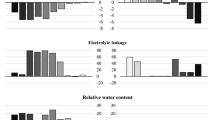Summary
Frost resistance, measured via the photosynthetic capacity after freeze-thaw treatment, and concentrations of sucrose, glucose and fructose of thalli of seven species of Bryidae and one species of Marchantiidae were determined from January to March and June to September, respectively. A distinct increase in cold tolerance from summer to winter was found in Polytrichum formosum Hedw., Atrichum undulatum (Hedw.) P. Beauv., Plagiomnium undulatum (Hedw.) Kop., Plagiomnium affine (Funck) Kop., Mnium hornum Hedw. and Pellia epiphylla (L.) Corda. While the frost resistance of the musci differed in summer and winter by 15° to more than 25° C, the hardening capacity of the thalloid liverwort was comparably low. Except in Mnium hornum, the increase in frost hardiness was accompanied by rise of the sucrose concentration in the cells, but insignificant changes in glucose and fructose contents. In contrast, Brachythecium rutabulum (Hedw.) B.S.G. and Hypnum cupressiforme Hedw. already exhibited high frost tolerances in summer, which coincided with high sucrose levels in the tissue, comparable to those found in other musci during the winter. Highly frost-resistant musci had total sugar concentrations around 90–140 mM, of which at least 80% and often more than 90% was sucrose. Artificial degradation of sucrose during exposure of mosses to higher temperatures resulted in a decline in cold hardiness. The results signify that the concentration of sugars, mainly of sucrose, may be important for the frost tolerance of bryophytes.
Similar content being viewed by others
References
Albon N, Gross D (1952) The chromatographic determination of raffinose in raw sugars. Improvements in technique. Analyst 77:410–412
Antropova TA (1974) The seasonal changes of cold and heat resistance of cells in two moss species. Bot Zh 59:117–122
Bergmever HU (1974) Methoden der enzymatischen Analyse, 3rd edn. Verlag Chemie, Weinheim
Clausen E (1964) The tolerance of hepatics to desiccation and temperature. Bryologist 67:411–417
Dilks TJK, Proctor MCF (1975) Comparative experiments on temperature responses of bryophytes: assimilation, respiration and freezing damage. J Bryol 8:317–336
Dircksen A (1964) Vergleichende Untersuchungen zur Frost-, Hitzeund Austrocknungsresistenz einheimischer Laub-und Lebermoose unter besonderer Berücksichtingung jahreszeitlicher Veränderungen. Dissertation Göttingen
Heber U, Santarius KA (1973) Cell death by cold and heat and resistance to extreme temperatures. Mechanisms of hardening and dehardening. In: Precht H, Christophersen J, Hensel H, Larcher W (eds) Temperature and life. Springer, Berlin Heidelberg New York, pp 232–263
Heber U, Santarius KA (1976) Water stress during freezing. In: Lange OL, Kappen L, Schulze E-D (eds) Water and plant file (Ecological studies, vol 19). Springer, Berlin Heidelberg New York, pp 253–267
Hegnauer R (1986) Chemotaxonomie der Pflanzen, vol 7. Birkhäuser, Basel, pp 374–396
Hicklenton PR, Oechel WC (1977) Physiological aspects of the ecology of Dicranum fuscescens in the subarctic. II. Seasonal patterns of organic nutrient content. Can J Bot 55:2168–2177
Hudson MA, Brustkern P (1965) Resistance of young and mature leaves of Mnium undulatum (L.) to frost. Planta 66:135–155
Irmscher E (1912) Über die Resistenz der Laubmoose gegen Austrocknung und Kälte. Jahrb Wiss Bot 50:387–449
Krause GH, Klosson RJ, Tröster U (1982) On the mechanisms of freezing injury and cold acclimation of spinach leaves. In: Li PH, Sakai A (eds) Plant cold hardiness and freezing stress. Mechanisms and crop implications, vol 2. Academic Press, New York, pp 55–75
Krebs KG, Heusser D, Wimmer H (1967) Sprühreagentien. In: Stahl E (ed) Dünnschichtchromatographie. Ein Laboratoriumshandbuch, 2nd edn. Springer, Berlin Heidelberg New York, pp 813–859
Levitt J (1980) Responses of plants to environmental stresses, vol 1. Chilling, freezing, and high temperature stresses, 2nd edn. Academic Press, New York
Lineberger RD, Steponkus PL (1980) Cryoprotection by glucose, sucrose and raffinose to chloroplast thylakoids. Plant Physiol 65:298–304
Malek L, Bewley JD (1978) Effects of various rates of freezing on the metabolism of a drought-tolerant plant, the moss Tortula ruralis. Plant Physiol 61:334–338
Mazur P (1969) Freezing injury in plants. Annu Rev Plant Physiol 20:419–448
Pihakaski K, Pihakaski S (1979) Effects of chilling on the ultrastructure and net photosynthesis of Pellia epiphylla. Ann Bot 43:773–781
Proctor MCF (1981) Physiological ecology of bryophytes. In: Schultze-Motel W (ed) Advances in bryology. Cramer, Vaduz, pp 79–166
Riedmüller-Schölm HE (1974) The temperature resistance of Alaskan plants from the continental boreal zone. Flora 163:230–250
Rütten D, Santarius KA (1992) Age-related differences in frost sensitivity of the photosynthetic apparatus of two Plagiomnium species. Planta 187:224–229
Sakai A, Larcher W (1987) Frost survival of plants. Responses and adaptation to freezing stress. (Ecological studies, vol 62). Springer, Berlin Heidelberg New York
Santarius KA, Giersch C (1983) Cryopreservation of spinach chloroplast membranes by low-molecular-weight carbohydrates. II. Discrimination between colligative and non-colligative protection. Cryobiology 20:90–99
Santarius KA, Giersch C (1984) Factors contributing to inactivation of isolated thylakoid membranes during freezing in the presence of variable amounts of glucose and NaCl. Biophys J 46:129–139
Santarius KA, Milde H (1977) Sugar compartmentation in frosthardy and partially dehardened cabbage leaf cells. Planta 136:163–166
Silvola J (1985) CO2 dependence of photosynthesis in certain forest and peat mosses and simulated photosynthesis at various actual and hypothetical CO2 concentrations. Lindbergia 11:86–93
Trunova TI (1970) Sugar accumulation in chloroplasts of winter wheat plants during frost hardening. Soviet Plant Physiol 17:751–754
Umbreit WW, Burris RH, Staufer JF (1968) Manometric techniques, 4th edn. Burgess, Minneapolis
Valanne N (1984) Photosynthesis and photosynthetic products in mosses. In: Dyer AF, Duckett JG (eds) The experimental biology of bryophytes. Academic Press, New York, pp 257–273
Author information
Authors and Affiliations
Rights and permissions
About this article
Cite this article
Rütten, D., Santarius, K.A. Relationship between frost tolerance and sugar concentration of various bryophytes in summer and winter. Oecologia 91, 260–265 (1992). https://doi.org/10.1007/BF00317794
Received:
Accepted:
Issue Date:
DOI: https://doi.org/10.1007/BF00317794




